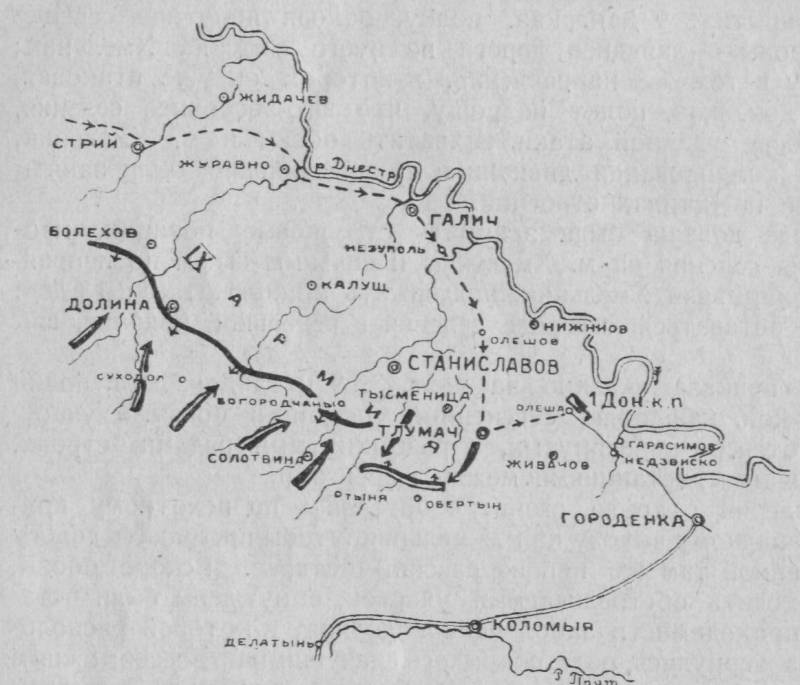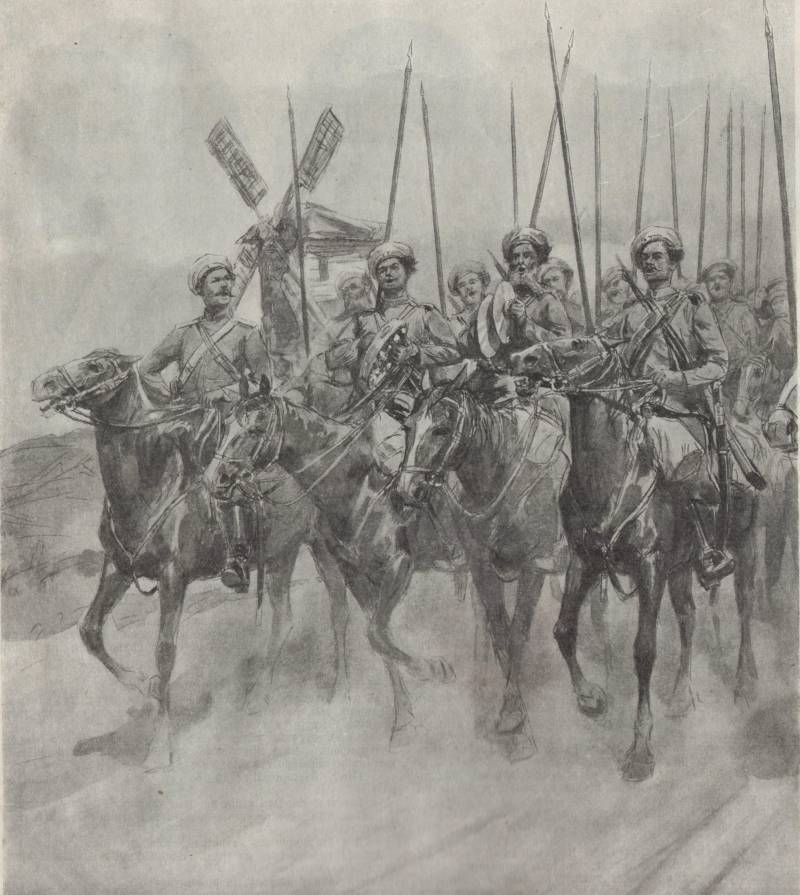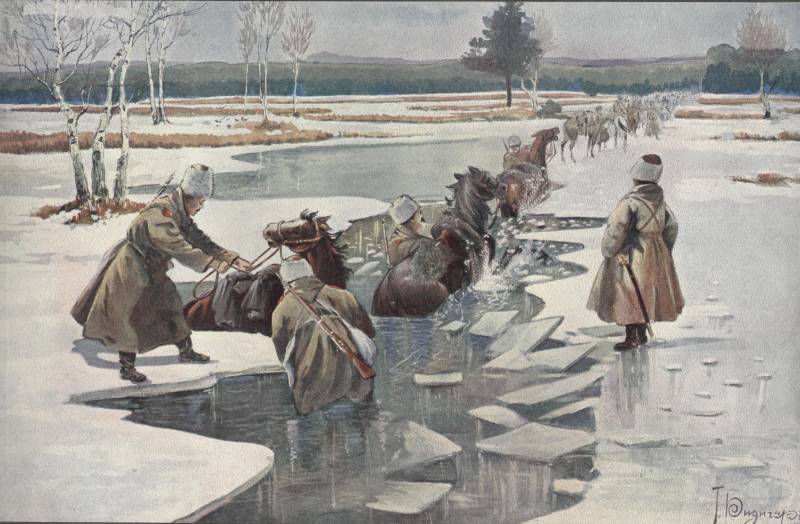Nezviski. Attack of the Russian cavalry
The Austrian armies on the Carpathian front strained their last forces, trying to unblock the fortress of Przemysl besieged by the Russian troops, and almost all along the Galician front went on the offensive. Surviving cartridge and shell "hunger" Russian armies, nevertheless, launched a counterattack. The fighting was particularly tense on the southern flank - the front of the Russian 9 Army. Three cavalry divisions (Caucasian Native cavalry, Terskaya Cossack and 12 Cavalry) were concentrated on the left flank of this operative association - the cavalry group was supposed to bypass the enemy’s right flank in the Nizhnyyiv-Tlumach-Tysmenitsa area and, acting on communications, would contribute to its defeat. But these compounds in the area of the town of Tlumach were stopped by Austrian infantry, with which they fought hard. The round was broken. Then the command of the 9 Army transferred another cavalry division to Nizhniyv - the 1-th Don Cossack, which received a directive to find the external flank of the enemy front in the area of Obertyn, bypassing it, and contributing to the success of the army battle on the enemy’s rear.

The area of action 1-th Don Cossack Division.
Cavalry street fight.
K 24. 02. 1915 of the year 1-I Don Cossack Division concentrated in with. Olesha, having advanced the 13-th Don Cossack regiment in with. Zhivachov. The latter had a skirmish of the Cossack patrols with the enemy, who retreated to Obertyn. Captures failed to capture, and the situation remained unclear.
The division received an order to move to the town of Gorodenka, since it was believed that Obertyn was busy with the enemy - it was decided to look for ways to the enemy rear in the area of Kolomyya. In the vanguard had to follow the 10-th Don Cossack regiment, and occupied with. Zhivachov 13 th Don Cossack regiment had to remain in place until the main forces approached with. Nezviska, being a side vanguard and covering the column from the side with. Obertyn.
In 10 hours 15 minutes 10 th Don Cossack regiment, just drawn into a. Nezviski, unexpectedly stumbled upon the vanguard of German cavalry columns moving towards the village street. Up to this point, parts of the 1-th Don Cossack Division did not encounter German troops - but the command personnel of the division and the Cossacks more than once expressed a desire to meet with the Germans. And now, unexpectedly confronted with the German cavalry, the head hundred regiment led by the commander, not thinking about the strength of the enemy, instantly rushed to the attack.
The avant-garde squadron of the enemy could not bear the impact and turned back. The machine-gun command of the German regiment under the command of Capt. Zestrasse quickly took up a position in a small wasteland of the village and opened fire on the hundred Russian that followed on the village street. But the cornet Lazarev, on his own initiative at the head of several Cossacks, separated himself from hundreds of units and launched an attack on the enemy machine guns. The machine gun crews were jumbled and chopped up, and Captain Zeestraße, bending his head to the side of the horse (trying to protect his head from the blow of Lazarev’s trotter with his sword), rushed back, but was overtaken and cut down by the initiative korunzhim.
Four hundreds of 10 Don Cossack regiments, following the vanguard and not yet retreating to the village street, turned left on the field map, bypassing the village and bursting through courtyards and side streets onto the main street of the village, and rushed to the peaks and checkers on the crowded this street German squadrons. For 15 minutes, under the blows of the rush and checkers of the Cossacks of the 10 of the Don Cossack Regiment, a significant part of the two German cavalry regiments - the 1 of the Leib Kirasirsky and 8 of the Dragoon — a brigade of the 5 of the cavalry division. The commander of this brigade escaped by car, and units of the German division, not yet drawn into the village, without taking the fight turned back - at Obertyn.
Cossacks pursued the enemy to Obertyn.
2 machine guns and the enemy’s cash drawer were captured, 10 officers and 31 soldiers from the 1 second Leib Kirasirsky and 8 dragoon regiments were captured (almost all were wounded by cold weapons) and 13 horses. But no more than 5 horses turned out to be fit - the backs of the others were continuous purulent wounds hidden under heavy saddles, and the injured horses were distributed to the local population.
The document stated that the corrée Lazarev, sergeant Bogucharskov, the clerk Krasnov and the Cossack Kurkin seized one operating German machine gun, while the second machine gun was seized by the Cossacks of the 3 and 6 of the hundreds. It is noted that 3 squadron of two German cavalry regiments was destroyed.
For capturing 24 in February 1915 of the current German machine gun Roman Lazarev was awarded the Order of St. George of the 4 degree. The serviceable machine gun was personally delivered by the officer to the division headquarters.
In the field bag of the killed captain Zehshtrasse, the gentleman of the Prussian Iron Cross, a letter-diary addressed but not sent to his wife was found, in which it was noted: "... from the intercepted enemy radiogram we learned about the movement of the enemy cavalry to our rear." From this it became clear that the enemy was known to the Russian radiotelegraph key, and the headquarters of the 1 Don Cossack Division immediately reported this to the headquarters of the 9 Army — the key was replaced with a new one.
But the formation did not succeed in leaving the rear flank of the enemy’s army, since two hours after the end of this battle the 1 of the Don Cossack Division had to engage in a fierce 3-day battle with the offensive from. Obertyn Austrian 65-m and 66-m infantry regiments. Division managed to keep with. Zhivachov and half of Nezviska, which three times passed from hand to hand. These enemy units prevented the divisions from entering the town of Gorodenka, and the element of tactical surprise was lost.

Cossacks in the campaign.
Horse attack in snowdrifts.
During these fights, 26 February near the villages. Nezviska occurred horse attack, in which one of the hundreds of Cossack managed to achieve fantastic results.
In the morning of this day a strong snowstorm began - and the wind blew in the face of the Austrians. At sunset, when the blizzard subsided, thick chains of the enemy appeared from Nezaviski - but with accurate fire 7-i Don Cossack battery stopped the advance of the Austrians.
In the evening, after 6 hours, the blizzard again blew out with the same force - people fell into the snow knee-deep and waist-deep, trenches were brought in with snow.
In such a situation, the Austrian infantry again went on the offensive and, without expecting a serious rebuff, approached the Russian positions. And at this moment 5-I hundred 10-th Don Cossack regiment, scattered into the lava, attacked the enemy.
The deep snow did not allow the cavalry to move quickly, the horses constantly fell into snowdrifts, but the mere sight of cavalry attacking in such conditions shook the enemy infantry. The attack of the Cossacks was supported by the soldiers of the 5 Infantry Regiment.
As a result, the 80 Cossacks and 126 Russian shooters eliminated the Austrian attack in 5 minutes. More than 200 Hungarian infantrymen died, and even before 200 was captured. An eyewitness recalled the terrible sight of these prisoners — half-frozen and blinded by a snowstorm, with frost-bitten hands. The rifles, covered with snow, refused to shoot, and the Hungarians, crying from the cold, cursed their command, which sent them towards the snowstorm and the Russian Cossacks.
Documents recorded: “25-th defense Nezviski. Shelling two batteries: German and Austrian. 26 th assault on the village 6 mouth Austrians. As a result of a counterattack of the 5, hundreds of 176 people were captured with the 2 officers of the 65 of the Hungarian infantry regiment and the 29 of the special battalion. ”
"In the 26 battle of February, near Nezvisk village, at night with a strong snowstorm that reached the chest of the horse, the Troika First Tears turned our company to the enemy’s retreating under the pressure of the enemy’s six mouths and attacked the enemy’s checkers, spikes and bayonets, and destroyed 210, taking the 176 prisoner under two officers of the Hungarian Infantry Regiment of the 65 and the 29 Special Battalion. For the described case, the Army Senior Officer Still-Lifes was awarded the St. George Weapon. ”
Thus, the Cossacks of the 10 Don Cossack Regiment proved that they could operate in a wide variety of conditions — by conducting a unique equestrian attack in a populated area (and having the nature of a head-on battle with the German cavalry), and attacking the advancing infantry of the enemy in heavy snowy terrain.

crossing the Cossack detachment.
Information